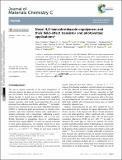Files in this item
Novel 4,8-benzobisthiazole copolymers and their field-effect transistor and photovoltaic applications
Item metadata
| dc.contributor.author | Conboy, Gary | |
| dc.contributor.author | Taylor, Rupert G. D. | |
| dc.contributor.author | Findlay, Neil J. | |
| dc.contributor.author | Kanibolotsky, Alexander L. | |
| dc.contributor.author | Inigo, Anto R. | |
| dc.contributor.author | Ghosh, Sanjay S. | |
| dc.contributor.author | Ebenhoch, Bernd | |
| dc.contributor.author | Krishnan Jagadamma, Lethy | |
| dc.contributor.author | Thalluri, Gopala Krishna V. V. | |
| dc.contributor.author | Sajjad, Muhammad T. | |
| dc.contributor.author | Samuel, Ifor D. W. | |
| dc.contributor.author | Skabara, Peter J. | |
| dc.date.accessioned | 2017-12-08T16:30:09Z | |
| dc.date.available | 2017-12-08T16:30:09Z | |
| dc.date.issued | 2017-12-07 | |
| dc.identifier | 251715440 | |
| dc.identifier | ebfa3dd1-f85d-48ef-be54-c4af18833047 | |
| dc.identifier | 85035043544 | |
| dc.identifier | 000416127400033 | |
| dc.identifier.citation | Conboy , G , Taylor , R G D , Findlay , N J , Kanibolotsky , A L , Inigo , A R , Ghosh , S S , Ebenhoch , B , Krishnan Jagadamma , L , Thalluri , G K V V , Sajjad , M T , Samuel , I D W & Skabara , P J 2017 , ' Novel 4,8-benzobisthiazole copolymers and their field-effect transistor and photovoltaic applications ' , Journal of Materials Chemistry , vol. 5 , no. 45 , pp. 11927-11936 . https://doi.org/10.1039/C7TC03959J | en |
| dc.identifier.issn | 0959-9428 | |
| dc.identifier.other | Bibtex: urn:93881c4039bd4c9e91a16537b7270539 | |
| dc.identifier.other | ORCID: /0000-0002-4339-2484/work/60196635 | |
| dc.identifier.uri | https://hdl.handle.net/10023/12302 | |
| dc.description | We are grateful to the EPSRC for funding through grants C, EP/L012294/1, EP/L017008/1 and EP/L012200/1 and to the European Research Council for funding from Grant 321305. Supporting data are accessible from 10.15129/9b457e8c-12bc-4a3a-9af3-7f53474f4e5c. | en |
| dc.description.abstract | A series of copolymers containing the benzo[1,2-d:4,5-d′]bis(thiazole) (BBT) unit has been designed and synthesised with bisthienyl-diketopyrrolopyrrole (DPP), dithienopyrrole (DTP), benzothiadiazole (BT), benzodithiophene (BDT) or 4,4′-dialkoxybithiazole (BTz) comonomers. The resulting polymers possess a conjugation pathway that is orthogonal to the more usual substitution pathway through the 2,6-positions of the BBT unit, facilitating intramolecular non-covalent interactions between strategically placed heteroatoms of neighbouring monomer units. Such interactions enable a control over the degree of planarity through altering their number and strength, in turn allowing for tuning of the band gap. The resulting 4,8-BBT materials gave enhanced mobility in p-type organic field-effect transistors of up to 2.16 × 10-2 cm2 V-1 s-1 for pDPP2ThBBT and good solar cell performance of up to 4.45% power conversion efficiency for pBT2ThBBT. | |
| dc.format.extent | 10 | |
| dc.format.extent | 3478849 | |
| dc.language.iso | eng | |
| dc.relation.ispartof | Journal of Materials Chemistry | en |
| dc.subject | QD Chemistry | en |
| dc.subject | DAS | en |
| dc.subject | SDG 7 - Affordable and Clean Energy | en |
| dc.subject.lcc | QD | en |
| dc.title | Novel 4,8-benzobisthiazole copolymers and their field-effect transistor and photovoltaic applications | en |
| dc.type | Journal article | en |
| dc.contributor.sponsor | EPSRC | en |
| dc.contributor.sponsor | EPSRC | en |
| dc.contributor.sponsor | European Research Council | en |
| dc.contributor.institution | University of St Andrews. School of Physics and Astronomy | en |
| dc.contributor.institution | University of St Andrews. Condensed Matter Physics | en |
| dc.identifier.doi | https://doi.org/10.1039/C7TC03959J | |
| dc.description.status | Peer reviewed | en |
| dc.identifier.grantnumber | EP/L012294/1 | en |
| dc.identifier.grantnumber | ep/l017008/1 | en |
| dc.identifier.grantnumber | en |
This item appears in the following Collection(s)
Items in the St Andrews Research Repository are protected by copyright, with all rights reserved, unless otherwise indicated.

